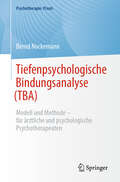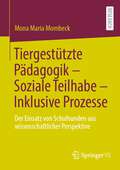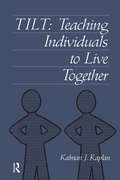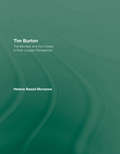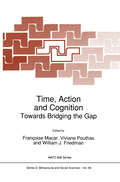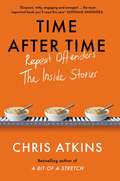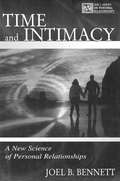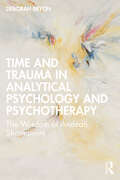- Table View
- List View
Tiefenpsychologische Bindungsanalyse: Modell und Methode – für ärztliche und psychologische Psychotherapeuten (Psychotherapie: Praxis)
by Bernd NockemannDiese Monografie wagt den Versuch, die Durcharbeitung der frühen, prägenden Bindungserfahrungen für das Setting der tiefenpsychologisch fundierten Psychotherapie zu erschließen. Der Autor lässt uns teilhaben an seinen Überlegungen zu einem streng naturwissenschaftlich gedachten Aufbau unserer aller Entwicklungs- und Veränderungsbedingungen, vom einfachen Reflex bis zur komplexen Bindungsbeziehung. Aus dem Inhalt: Die auffälligen Überschneidungen der Bindungstheorie und der Selbstpsychologie bilden den Kern der grundlegenden theoretischen Weiterentwicklung des psychodynamischen Modells. Mit den Begrifflichkeiten der Bindungstheorie gelingt es dem Autor, die Modellvorstellungen der Selbstpsychologie um entscheidende Elemente zu ergänzen. Psychodynamische Therapien werden mit der TBA überschaubarer, leichter zu handhaben (mit konkreten Fragen zur Bindungsgeschichte) und wirkungsvoller. Mit einem Geleitwort von Klaus E. Grossmann. Über den Autor: Bernd Nockemann ist niedergelassener Arzt für Psychosomatische Medizin und Psychotherapie in Radevormwald. Sein Anliegen ist, die Methode der Tiefenpsychologischen Bindungsanalyse den psychodynamisch orientierten Kolleginnen und Kollegen auf einer theoretisch gut fundierten und verständlichen Basis nutzbar zu machen. In seiner Freizeit liebt Bernd Nockemann Sport und das Zusammensein mit seiner Familie und Freunden am selbstgebauten Pizzaofen sowie die Interpretation gepflegter Polyphonie, von klassischen Oratorien bis Comedian Harmonists.
Tiergestützte Pädagogik – Soziale Teilhabe – Inklusive Prozesse: Der Einsatz von Schulhunden aus wissenschaftlicher Perspektive
by Mona Maria MombeckLehrkräfte setzen Hunde im Unterricht ein, um die soziale Inklusion zu fördern. Doch welchen Einfluss hat tiergestützte Pädagogik auf die sozialen Strukturen in Schulklassen? Wie lassen sich diese Einflüsse erklären und welche Schlussfolgerungen können für die Förderung von sozialer Inklusion abgeleitet werden? Diese Fragen werden mit einer der ersten empirischen Erhebungen zu Auswirkungen tiergestützter Pädagogik auf die soziale Partizipation von Schüler*innen beantwortet. Der Einfluss von Schulhunden wird gezielt hinsichtlich des Wohlbefindens, der Arbeitsatmosphäre und sozialer Beziehungen zwischen den Lernenden, aber auch zwischen Klasse und Lehrkraft erhoben. Die Analyse der Ergebnisse zeigt: Mithilfe von tiergestützter Pädagogik werden soziale Strukturen positiv beeinflusst und Teilhabemöglichkeiten geschaffen. Vor dem Hintergrund pädagogischer und soziologischer Theorien werden die Ergebnisse interpretiert und erklärt. Leser*innen erhalten praktische Hinweise für die Förderung sozialer und emotionaler Entwicklung von Kindern und Jugendlichen sowie für die Vermittlung inklusiver Werte und die Beziehungsgestaltung.
Tiergestützte Therapie mit Hunden: Grundlagen, Tierethik und Praxis der therapeutischen Arbeit
by Katharina BleschDie tiergestützte Therapie ist seit einigen Jahren in aller Munde und wird immer häufiger auch in die psychotherapeutische Behandlung von Menschen integriert. Doch wie genau können Therapiebegleithunde die psychotherapeutische Arbeit erweitern und unterstützen? Wie lassen sich dabei Tierschutz und Menschenwohl vereinen? Welche Hunde eignen sich für den Einsatz als Therapiebegleithund und wie werden sie auf ihren Einsatz vorbereitet?Mit diesem Fachbuch erhalten Sie einen praxisnahen und lebendigen Einblick in die therapeutische Arbeit mit Hunden. Neben einem Überblick über die Grundlagen sowie tierschutzrechtliche und ethische Aspekte der hundegestützten Therapie von Menschen werden konkrete Übungen im Rahmen eines hundegestützten Selbstsicherheitstrainings bildhaft und per Video beschrieben und geben so Inspiration für die therapeutische Arbeit mit Mensch und Tier in verschiedenen Institutionen und Situationen.
Tierisch kultiviert - Menschliches Verhalten zwischen Kultur und Evolution
by Ulrich KühnenDie Weisheit im Kopf, den Affen im Rucksack Fremde Länder, fremde Sitten, sagt bereits der Volksmund: Unsere Kultur prägt, wie wir denken, fühlen und handeln. Zugleich jedoch sind wir Teil der Tierwelt, und auch „der Affe in uns“ wird immer wieder sichtbar. Wir sind zugleich kulturbegabt und doch nur höher entwickelte Primaten. Aber welche Anteile unseres Verhaltens sind kulturell geformt, welche evolutionär? Wie tiefgreifend bestimmt die Kultur unser Denken und wann schlägt doch unser äffisches Erbe durch? Wie wurden wir überhaupt zu Kulturwesen und wieso entwickelten sich die Kulturen so unterschiedlich? Formt unsere Kultur auch, was wir sehen und wahrnehmen? Wollen Männer wirklich immer nur das eine? Wie entwickeln wir moralische Vorstellungen? Hat das Gute eine Chance in einer feindlichen Umwelt? Wo kommt das Mitgefühl her? Wieso glauben wir an Gott? Dieses Buch nimmt den Leser mit auf eine spannende Reise in die Tiefen des Bewusstseins und vermittelt verblüffende Einsichten in die Grundlagen unseres Erlebens und Verhaltens. Die großen Fragen des Lebens werden auf erfrischend neue Weise betrachtet, indem jüngste Erkenntnisse der kulturvergleichenden Forschung und der Evolutionspsychologie im Zusammenhang betrachtet werden. Auf anschauliche und teils überraschende Weise wird dem Leser vor Augen geführt, wie relativ doch die eigenen Sichtweisen oft sind. Ein Buch für alle Leser, die sich immer wieder neu die alte Frage stellen: Wer bin ich? _____ Der Mensch ist kulturbegabt und zugleich Teil der Tierwelt dieses Planeten. Er kann frei entscheiden, was er tun will, und hat enorme kulturelle Leistungen hervorgebracht; zugleich spiegeln seine Verhaltensweisen oftmals sehr alte evolutionäre Programme wider. Wo verlaufen die Grenzen, wo sind die Schnittstellen zwischen kulturell geformten und evolutionär geprägten Verhaltensanteilen? Lassen sie sich überhaupt voneinander trennen? Bestimmt die Kultur unser Denken und unsere Wahrnehmung - oder ist doch unser Primatenerbe maßgeblich? Wie entsteht unser inneres Bild von uns selbst und wie beeinflusst es, was wir tun? Warum können wir sowohl einfühlsam und sanftmütig als auch selbstsüchtig und gewalttätig agieren? Was ist die Natur des Menschen? Dies sind nur einige der vielen spannenden Fragen, denen dieses leicht verständlich und mit Humor geschriebene Buch nachgeht. Es zeigt, warum wir Menschen zwar oftmals die Weisheit im Kopf haben, aber dann doch von dem Affen in unserem Rucksack die Richtung gewiesen bekommen.
The Ties of Later Life (Perspectives On Aging And Human Development Ser.)
by Jon HendricksHelps you recognise the continuity that runs across the generations from grandparents to grandchildren. This work provides a clear perspective on the actual experiences of the lives of our family and friends.
The Ties of Later Life (Perspectives On Aging And Human Development Ser.)
by Jon HendricksHelps you recognise the continuity that runs across the generations from grandparents to grandchildren. This work provides a clear perspective on the actual experiences of the lives of our family and friends.
Tilt: Teaching Individuals To Live Together
by Kalman J. KaplanAn alternative to existing bipolar choices, this book looks at individuals and their distances from the self (individuation-deindividuation) and from others (attachment-detachment). Simultaneously theoretical, empirical, and applied, this book can be reasonably applied to all types of individuals involved in interpersonal situations regardless of culture, age, gender, or sexual orientations. Broken into four parts, In the first part, Definitions and Measurements, the author includes an introduction to the Individuation-Attachment Questionnaire.Implications of TILT for Individuals is the basis for part two and includes a view of TILT across the life span. The next section extends the analysis to TILT for Couples and Families. The clinician, counselors, and individuals attempting to help himself/herself are addressed in the final part: TILT for the Clinician and includes application of TILT to everyday life.The text brings to life, through extensive description, the questions and situations consistently raised in couples therapy: space-too much or not enough. TILT: Teaching Individuals To Live Together presents a unique model of individuation and attachment and was developed to facilitate the understanding of the complex relationship between these two developmental processes across the life span. The model shows how we gradually develop our boundaries and hence reduce the need for defensive interpersonal walls. The TILT Model has applications in the fields of therapy, education, and organizational development. Thus, it will be of interest to mental health professionals including psychotherapists, psychologists, counselors, social workers, and marriage and family therapists. Practitioners of transactional analysis will find this book of supreme interest and usefulness.
Tilt: Teaching Individuals To Live Together
by Kalman J. KaplanAn alternative to existing bipolar choices, this book looks at individuals and their distances from the self (individuation-deindividuation) and from others (attachment-detachment). Simultaneously theoretical, empirical, and applied, this book can be reasonably applied to all types of individuals involved in interpersonal situations regardless of culture, age, gender, or sexual orientations. Broken into four parts, In the first part, Definitions and Measurements, the author includes an introduction to the Individuation-Attachment Questionnaire.Implications of TILT for Individuals is the basis for part two and includes a view of TILT across the life span. The next section extends the analysis to TILT for Couples and Families. The clinician, counselors, and individuals attempting to help himself/herself are addressed in the final part: TILT for the Clinician and includes application of TILT to everyday life.The text brings to life, through extensive description, the questions and situations consistently raised in couples therapy: space-too much or not enough. TILT: Teaching Individuals To Live Together presents a unique model of individuation and attachment and was developed to facilitate the understanding of the complex relationship between these two developmental processes across the life span. The model shows how we gradually develop our boundaries and hence reduce the need for defensive interpersonal walls. The TILT Model has applications in the fields of therapy, education, and organizational development. Thus, it will be of interest to mental health professionals including psychotherapists, psychologists, counselors, social workers, and marriage and family therapists. Practitioners of transactional analysis will find this book of supreme interest and usefulness.
Tim Burton: A Post-Jungian Perspective
by Helena Bassil-MorozowTim Burton’s films are well known for being complex and emotionally powerful. In this book, Helena Bassil-Morozow employs Jungian and post-Jungian concepts of unconscious mental processes along with film semiotics, analysis of narrative devices and cinematic history, to explore the reworking of myth and fairytale in Burton’s gothic fantasy world. The book explores the idea that Burton’s lonely, rebellious ‘monstrous’ protagonists roam the earth because they are unable to fit into the normalising tendencies of society and become part of ‘the crowd’. Divided into six chapters the book considers the concept of the archetype in various settings focusing on: the child the monster the superhero the genius the maniac the monstrous society. Tim Burton: The Monster and the Crowd offers an entirely fresh perspective on Tim Burton’s works. The book is essential reading for students and scholars of film or Jungian psychology, as well as anyone interested in critical issues in contemporary culture. It will also be of great help to those fans of Tim Burton who have been searching for a profound academic analysis of his works.
Tim Burton: A Post-Jungian Perspective
by Helena Bassil-MorozowTim Burton’s films are well known for being complex and emotionally powerful. In this book, Helena Bassil-Morozow employs Jungian and post-Jungian concepts of unconscious mental processes along with film semiotics, analysis of narrative devices and cinematic history, to explore the reworking of myth and fairytale in Burton’s gothic fantasy world. The book explores the idea that Burton’s lonely, rebellious ‘monstrous’ protagonists roam the earth because they are unable to fit into the normalising tendencies of society and become part of ‘the crowd’. Divided into six chapters the book considers the concept of the archetype in various settings focusing on: the child the monster the superhero the genius the maniac the monstrous society. Tim Burton: The Monster and the Crowd offers an entirely fresh perspective on Tim Burton’s works. The book is essential reading for students and scholars of film or Jungian psychology, as well as anyone interested in critical issues in contemporary culture. It will also be of great help to those fans of Tim Burton who have been searching for a profound academic analysis of his works.
TIMBER Psychotherapy: For PTSD, Depression and Traumatic Psychosis
by Basant Pradhan Narsimha R. Pinninti Shanaya RathodTIMBER psychotherapy is a novel, translational and biomarker informed, mindfulness-based cognitive behavioral therapy approach that addresses some of the current treatment gaps for PTSD, depression and traumatic psychosis. This treatment manual offers practitioners and patients alike a step-by-step guide to TIMBER (acronym for Trauma Interventions using Mindfulness Based Extinction and Reconsolidation of memories) psychotherapy, and has been divided into four parts: Understanding Complex Trauma and Traumatic Psychosis; Methodology and Application; Training Professionals; and Policy Implications & Future Research Directions. In addition to a strong rationale and evidence base for the TIMBER approach, the book also provides case examples accompanied by videos (available separately). Its special features include reproducible client handouts, assessment tools, and a list of resources for training to use TIMBER.
Time, Action and Cognition: Towards Bridging the Gap (NATO Science Series D: #66)
by William J. Friedman VivianePouthas FrançoiseMacarThis volume is the outcome of the NATO Advanced Research Workshop on Time, Action and Cognition. which was held in Saint-Malo, France, in October 1991. The theme - time in action and cognition of time - was sparked by growing awareness in informal meetings between mostly French-speaking time psychologists of the need to bring together time specialists in the areas of development, motor behavior, attention, memory and representations. The workshop was designed to be a forum where different theoretical points of view and a variety of empirical approaches could be presented and discussed. Time psychologists tended to draw conclusions restricted to their specific fields of interest. From our own experience, we felt that addressing a common issue - possible relationships between time in action and representations of time - could lead to a more comprehensive approach. We are endebted to NATO for allowing us to bring this idea to fruition. We take this opportunity as well to express our thanks to Cognisciences ( Cognisud section) -- an active interdisciplinary research organization - for its financial backing and the CNRS for its scientific support.
Time After Time: The Inside Story of Why Prisoners Reoffend
by Chris AtkinsBritish prisoners have to endure the most inhumane and barbaric conditions imaginable, so why do so many of them keep going back? Former inmate and documentary maker Chris Atkins has spent the last six years tracking the fortunes of a dozen repeat offenders to understand why the state fails to keep them out of trouble. Featuring funny, wild, and funny stories, Time After Time exploits Chris's unprecedented access to the criminal underworld to understand why the system actually makes reoffending all but inevitable for ex prisoners.
Time and Behaviour: Psychological and Neurobehavioural Analyses (ISSN #Volume 120)
by C. M. Bradshaw E. SzabadiThat time is both a dimension of behaviour and a ubiquitous controlling variable in the lives of all living things has been well recognized for many years. The last decade has seen a burgeoning of interest in the quantitative analysis of timing behaviour, and progress during the last five or six years has been particularly impressive, with the publication of several major new theoretical contributions. There has also been considerable progress in behavioural methodology during the past decade. In the area of reinforcement schedules, for example, the venerable interresponse–time schedule, fixed–interval peak procedure and interval bisection task have been complemented by a 'second generation' of incisive instruments for analyzing timing behaviour. Another area of recent development is the analysis of the neurobiological substrate of timing behaviour. Several research groups are currently studying the involvement of various central neurotransmitter systems in the timing behaviour, and the ability of centrally acting drugs and discrete brain lesions to alter timing processes. Yet another recent development in timing research is the growing dialogue between two fields that have grown up separately, although, superficially at least, they seem to have much in common: the experimental analysis of 'interval timing', traditionally the province of experimental psychology, and behavioural chronobiology. The last few years have seen a growing interest in the comparative properties of the internal 'clocks' that regulate biobehavioural rhythms with time bases in the circadian range or longer, and those that are entailed in timing of intervals in the range of seconds or minutes. All these areas of research, and others, are represented in the chapters that make up this volume. This book will help to promote further interactions among researchers who hail from disparate disciplines, but who share a common interest in the temporal properties of behaviour.
Time and Human Cognition: A Life-Span Perspective (ISSN #Volume 59)
by I. Levin D. ZakayEach chapter in this book is written by, and devoted to the original work of a leading researcher in his or her own field. The book presents an integrative approach to the psychological study of time in an attempt to bring to light similarities between bodies of research which have been developed independently within different theoretical frameworks - from Piaget's structuralist-organismic model, to information processing approaches. The chapters are organized in a life-span perspective, with different chapters focusing on different age-levels. It includes analyses of time perception in infancy, temporal systems in the developing language, time conception, time measurement and time reading in middle childhood and adolescence, as well as various models of time perception in the adult, both normal and abnormal.A rich concept such as time sheds light on a wide variety of major topics in psychology; the book will be of value to cognitive, developmental and educational psychologists, as well as to psycholinguists.
Time and Intimacy: A New Science of Personal Relationships (LEA's Series on Personal Relationships)
by Joel B. BennettThere is a mysterious connection between our experiences of intimacy--of love, the longing to feel connected, and sexual embrace--and the human sense of time--eternity, impermanence, and rhythm. In this critical analysis of the time-intimacy equation, Bennett shows how the scientific study of personal relationships can address this mystery. As a study of transpersonal science, this book points to the possible evolution of intimacy and of our consciousness of time, and how the two evolutionary paths weave together. Dr. Bennett draws from a wide array of resources to advance and marry two compelling themes: first, the social and clinical science of personal relationships should integrate the spiritual or transpersonal dimension of intimacy, and second, science can contribute to lay understandings by describing the richly temporal aspects of relationships. In blending popular literature, transpersonal psychology, and scientific research and theory, this work also attempts to address the lack of dialogue between academics who study personal intimacy and those writers in the popular press who give advice and guidelines for building intimacy. Time and Intimacy is written for a broad audience, intended for those with a general interest in relationships, as well as for students, counselors, and psychologists. It can be used as a text in courses on personal relationships, as well as to supplement courses in humanistic psychology, transpersonal psychology, interpersonal communication, relationships, marital and family counseling, human relations, and related areas. Because it advances an interdisciplinary understanding of personal relationships, this book is certain to challenge prevailing views about the meaning of intimacy in both the academic and popular literatures.
Time and Intimacy: A New Science of Personal Relationships (LEA's Series on Personal Relationships)
by Joel B. BennettThere is a mysterious connection between our experiences of intimacy--of love, the longing to feel connected, and sexual embrace--and the human sense of time--eternity, impermanence, and rhythm. In this critical analysis of the time-intimacy equation, Bennett shows how the scientific study of personal relationships can address this mystery. As a study of transpersonal science, this book points to the possible evolution of intimacy and of our consciousness of time, and how the two evolutionary paths weave together. Dr. Bennett draws from a wide array of resources to advance and marry two compelling themes: first, the social and clinical science of personal relationships should integrate the spiritual or transpersonal dimension of intimacy, and second, science can contribute to lay understandings by describing the richly temporal aspects of relationships. In blending popular literature, transpersonal psychology, and scientific research and theory, this work also attempts to address the lack of dialogue between academics who study personal intimacy and those writers in the popular press who give advice and guidelines for building intimacy. Time and Intimacy is written for a broad audience, intended for those with a general interest in relationships, as well as for students, counselors, and psychologists. It can be used as a text in courses on personal relationships, as well as to supplement courses in humanistic psychology, transpersonal psychology, interpersonal communication, relationships, marital and family counseling, human relations, and related areas. Because it advances an interdisciplinary understanding of personal relationships, this book is certain to challenge prevailing views about the meaning of intimacy in both the academic and popular literatures.
Time and Memory
by Rosine Jozef PerelbergThe concern with time permeates Freud's work, from Studies on Hysteria to Analysis Terminable and Interminable, which point out to a network of concepts that indicate Freud's complex theories on temporality. Indeed no other psychoanalytic thinker has put forward such revolutionary vision on the dimensions of time in human existence. This volume brings together some of the most important papers written on the topic by members of the British Psychoanalytical Society. In the richness of the detailed clinical discussions the ways in which patients deal with time and memory are viewed as crucial indications about their internal world and ways of relating to their objects. Disorientation regarding time tends to reflect levels of disruption to internal object relationships, inability to mourn or to experience guilt. Examples from literature and history are considered in order to examine the power of the repetition compulsion - Nachtreglichkeit - as well as how the impossibility of bearing the mental pain can lead to the creation of a timeless world.
Time and Memory (Psychoanalytic Ideas Ser.)
by Paul Williams Rosine Jozef Perelberg Inge WiseThe concern with time permeates Freud's work, from Studies on Hysteria to Analysis Terminable and Interminable, which point out to a network of concepts that indicate Freud's complex theories on temporality. Indeed no other psychoanalytic thinker has put forward such revolutionary vision on the dimensions of time in human existence. This volume brings together some of the most important papers written on the topic by members of the British Psychoanalytical Society. In the richness of the detailed clinical discussions the ways in which patients deal with time and memory are viewed as crucial indications about their internal world and ways of relating to their objects. Disorientation regarding time tends to reflect levels of disruption to internal object relationships, inability to mourn or to experience guilt. Examples from literature and history are considered in order to examine the power of the repetition compulsion - Nachtreglichkeit - as well as how the impossibility of bearing the mental pain can lead to the creation of a timeless world.
Time and the Psyche: Jungian Perspectives
by Angeliki YiassemidesIn Time and the Psyche, a diverse selection of contributors explores the multi-layered aspects of time through the lens of analytical psychology. The book aims to bridge the gap between theory and practice, emphasising time's fundamental role in the workings and expressions of the psyche, and additionally exploring cultural and clinical dimensions. The contributors deal with temporality in our inner world and its manifestations as expressed by products of our psyche, covering topics including disturbances of temporality within the psychoanalytic session, the acausal connecting principle of synchronicity, time as expressed in film, objects, literature, and culture, and temporality as understood in various types of dreams and imaginary practices. The book also explores the time-bound world, time versus timelessness, the realm of the eternal, human versus cosmic time, Chronos versus Kairos and other temporality-related dimensions and their relationship to our psyche and our experience in the world. With contributors from backgrounds in clinical work, the arts, literature, and philosophy, this collection is unique in its scope. Time and the Psyche is a thought-provoking reading for academics and students of Jungian and post-Jungian studies, analytical psychologists and Jungian analysts in practice and in training.
Time and the Psyche: Jungian Perspectives
by Angeliki YiassemidesIn Time and the Psyche, a diverse selection of contributors explores the multi-layered aspects of time through the lens of analytical psychology. The book aims to bridge the gap between theory and practice, emphasising time's fundamental role in the workings and expressions of the psyche, and additionally exploring cultural and clinical dimensions. The contributors deal with temporality in our inner world and its manifestations as expressed by products of our psyche, covering topics including disturbances of temporality within the psychoanalytic session, the acausal connecting principle of synchronicity, time as expressed in film, objects, literature, and culture, and temporality as understood in various types of dreams and imaginary practices. The book also explores the time-bound world, time versus timelessness, the realm of the eternal, human versus cosmic time, Chronos versus Kairos and other temporality-related dimensions and their relationship to our psyche and our experience in the world. With contributors from backgrounds in clinical work, the arts, literature, and philosophy, this collection is unique in its scope. Time and the Psyche is a thought-provoking reading for academics and students of Jungian and post-Jungian studies, analytical psychologists and Jungian analysts in practice and in training.
Time and Timelessness: Temporality in the theory of Carl Jung (Research in Analytical Psychology and Jungian Studies)
by Angeliki YiassemidesTime and Timelessness examines the development of Jung's understanding of time throughout his opus, and the ways in which this concept has affected key elements of his work. In this book Yiassemides suggests that temporality plays an important role in many of Jung's central ideas, and is closely interlinked with his overall approach to the psyche and the cosmos at large. Jung proposed a profound truth: that time is relative at large. To appreciate the whole of our experience we must reach beyond causality and temporal linearity, to develop an approach that allows for multidimensional and synchronistic experiences. Jung’s understanding surpassed Freud's dichotomous approach which restricted timelessness to the unconscious; his time theory allows us to reach beyond the everyday time-bound world into a greater realm, rich with meaning and connection. Included in the book: -Jung’s time theory -the death of time -time and spatial metaphors -the role of time in precognition, telepathy and synchronicity -Unus mundus and time -a comparison of Freud’s and Jung’s time theories: temporal directionality, dimensionality, and the role of timelessness. This book is the first to explore time and timelessness in a systematic manner from a Jungian perspective, and the first to investigate how the concept of time affected the overall development of Jung's theory. It will be key reading for psychoanalytic scholars and clinicians, as well as those working in the field of phenomenological philosophy.
Time and Timelessness: Temporality in the theory of Carl Jung (Research in Analytical Psychology and Jungian Studies)
by Angeliki YiassemidesTime and Timelessness examines the development of Jung's understanding of time throughout his opus, and the ways in which this concept has affected key elements of his work. In this book Yiassemides suggests that temporality plays an important role in many of Jung's central ideas, and is closely interlinked with his overall approach to the psyche and the cosmos at large. Jung proposed a profound truth: that time is relative at large. To appreciate the whole of our experience we must reach beyond causality and temporal linearity, to develop an approach that allows for multidimensional and synchronistic experiences. Jung’s understanding surpassed Freud's dichotomous approach which restricted timelessness to the unconscious; his time theory allows us to reach beyond the everyday time-bound world into a greater realm, rich with meaning and connection. Included in the book: -Jung’s time theory -the death of time -time and spatial metaphors -the role of time in precognition, telepathy and synchronicity -Unus mundus and time -a comparison of Freud’s and Jung’s time theories: temporal directionality, dimensionality, and the role of timelessness. This book is the first to explore time and timelessness in a systematic manner from a Jungian perspective, and the first to investigate how the concept of time affected the overall development of Jung's theory. It will be key reading for psychoanalytic scholars and clinicians, as well as those working in the field of phenomenological philosophy.
Time and Trauma in Analytical Psychology and Psychotherapy: The Wisdom of Andean Shamanism
by Deborah BryonThis book explores the experience of time in psychoanalysis and Andean shamanism. It plots ways to work through unresolved trauma by expanding how we conceptualize both implicit and nonverbal atemporal experience, drawing from the rituals, narratives, and medicine of Andean shamans and quantum theory.Shifting between subjective states in time is fundamental in trauma work and psychoanalysis. Integrating traumatic experiences that have become split off and held in “timeless” unconscious states of implicit memory is an essential aspect of psychic healing. Becoming familiar with the Andean shamans’ understanding of atemporal experience, as well as learning about their ways of “grounding” the experience consciously, can offer a route through which psychoanalysis and therapy may deepen the therapeutic process and open new states of consciousness. Theories developed in quantum physics are included to parallel the shamans’ experience and for describing the analytic process.Written by a noted expert in this field, this insightful volume will interest trainee and practitioner analytical psychologists, as well as any professional interested in the resolution of trauma within a psychotherapeutic setting.
Time and Trauma in Analytical Psychology and Psychotherapy: The Wisdom of Andean Shamanism
by Deborah BryonThis book explores the experience of time in psychoanalysis and Andean shamanism. It plots ways to work through unresolved trauma by expanding how we conceptualize both implicit and nonverbal atemporal experience, drawing from the rituals, narratives, and medicine of Andean shamans and quantum theory.Shifting between subjective states in time is fundamental in trauma work and psychoanalysis. Integrating traumatic experiences that have become split off and held in “timeless” unconscious states of implicit memory is an essential aspect of psychic healing. Becoming familiar with the Andean shamans’ understanding of atemporal experience, as well as learning about their ways of “grounding” the experience consciously, can offer a route through which psychoanalysis and therapy may deepen the therapeutic process and open new states of consciousness. Theories developed in quantum physics are included to parallel the shamans’ experience and for describing the analytic process.Written by a noted expert in this field, this insightful volume will interest trainee and practitioner analytical psychologists, as well as any professional interested in the resolution of trauma within a psychotherapeutic setting.
